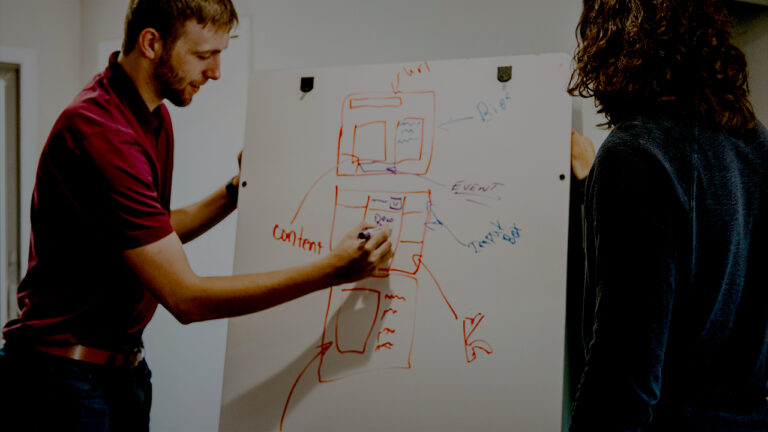Every year I take the liberty of perusing the conference circuit and various industry publications, to get a sense of what’s on the minds and hearts of folks in this wacky world of brand consultancy. Call it my duty as an industry professional. Call it a geeky pastime. Even call it a form of punishment. But I’m always jazzed to see what I can discover, each and every time.
Last year in an article I called The Musings of a Modern-day Qualie, I couldn’t help but notice the angst that people were experiencing, on a very deep, visceral level… seemingly all in response to the ‘speed of change’. Brands were feeling the pressure to get to market sooner, so suppliers felt the pressure to deliver insight sooner. It was like a race to the finish line. The only thing was, the work never seemed to finish. Or, if you reached the finish line, you were only met with another finish line a little further ahead.
It was also hard to ignore the sheer volume of research tools and technologies that seemed to be sprouting up by the minute. Which meant MORE DATA… for us to collect and analyze and for our clients to glean from.
So what’s the punchline you ask? What revolutionary observations did I uncover this year?
Well, to be perfectly honest, some things didn’t change.
People are still going on about Biometrics.
People are still enamored by Behavioral Science.
People are still demanding Speed and Agility.
People are still curiously obsessed with the application of AI.
And people are still telling stories about the power of Storytelling.
And can we really expect it to change? Humbly, most of us are only on the edge of discovering the potential of these new tools and technologies and what they can offer to our work. Their full application is still a mystery, even to those who call themselves experts. The ROI is still far from clear. Let’s face it, there’s a reason why we’re still conducting focus groups, IDIs, and online surveys… over strapping a brain wave cap onto someone’s head or collecting their sweat in a petri dish. We know what we’re gonna get, warts and all.
But that’s not to say there hasn’t been any movement at all…
What does seem to be shifting ever so slightly, is our belief in these new tools and technologies, and more importantly how we perceive the relationship between ‘us’ and ‘it’. ‘Us’ being the researchers, strategists, data analysts, and consultants. And ‘It’ being the research tech and tools at our fingertips.
But first, let’s look at this shift in our belief. Initially, the mere mention of AI, VR, AR, and automation tickled our fancies. We were promised it had the power to make insights more actionable, more agile, more affordable, more meaningful, more novel, more profitable, more creative, and dare I say more human. It was something we didn’t quite understand but knew it was important to know enough about to engage in casual banter during a networking event or get through a LinkedIn article. But perhaps never quite enough to actually use in any profound way, on an actual project for an actual paying client, where results actually mattered.
Now however, it seems we are moving past the honeymoon stage, and are interrogating research tech and tools more. We’re starting to question their use and benefit to the work we do, separating the hype from what can truly help us. When is it appropropriate (or even ethical) to use these new tools and when is it not? What role does the consultant play when using these tools? What parts of what we do should be automated and what parts damn well shouldn’t?… are just some of the questions we seem to be asking ourselves.
As a result, we are witnessing a shift in the relationship between ‘us’ and ‘it’…
The dialogue between ‘us’ and ‘it’ used to be “Human vs. Machine”. How tech has the processing power to do the things only humans used to do. To collect the data. To analyze the data. To report out on the data. To disseminate the data. And more recently to identify bleeding-edge insight.
Now it seems, the dialogue between ‘us’ and ‘it’ is in the beginning stages of a profound transformation… moving away from the old “Human vs. Machine” song and dance, towards “Human + Machine”. This requires not looking at technology and human learning as two separate functions, but how they can function together… as one. Focusing less on the tension that arises when new tech is introduced and more on the harmony that can be achieved between a tool and its user. For example, a qualitative AI platform may pick up patterns in a large set of data in a tenth of the time, but it would be our job to interpret its meaning and communicate it to our clients in a human way.
But at the end of the day, the real question remains: What does this all mean for our clients and the work we deliver to them?
Well, in the advent of the growing tsunami of new tools and technologies (and hence MORE DATA) the pressure to be a ‘data driven company’ is on for brands. Which is a fancy way of saying that many companies are recognizing the inherent value in employing data (particularly about their consumer) to make informed business decisions. This is not to say human intuition and good ‘ol industry smarts don’t count for anything anymore. They do. Just in combination with data.
And speaking of data… clients are findings themselves with a shit ton of it. Whether it’s machine generated data or human generated data. Big data or small data. Qualitative data or quantitative data. Data from annual tracking studies, secondary digging, social listening efforts, or custom projects. It’s all coming in, and it’s coming in hot. Therefore, what continues to be the biggest challenge for clients is…
“How the hell do I make sense of it all?”
What brands are realizing is that simply surrounding themselves with more and more data is not going to make it any more meaningful for them… or more useful to make decisions with.
It all comes down to what impactful work really looks like. Not what it looks like to us, but what it looks like for our clients. For us, impact may mean delivering killer work during a custom project, where we witness the fruits of our efforts e.g. seeing the faces of pleased clients in the room, getting a flattering testimonial to drop on our website, seeing an ad campaign with our fingerprints all over it, yaddy yaddy yadda.
But to a client, impact means something entirely different. Something bigger. Bigger than a pithy headline or chart, bigger than a killer insight, and even bigger than the success of a single ad campaign.
Impact to a client means integration.
- It means integrating knowledge from multiple sources of data.
- It means applying this knowledge within the context of the brand.
- It means sharing/leveraging knowledge across the business, with all stakeholders who can benefit from it.
- It means managing knowledge in an efficient and user-friendly way.
- It means actioning knowledge by ensuring it is heard by those who have the power to make decisions.
…And it means working with the right teams who can effectively translate data into knowledge and do all of the above like fucking champs.
That’s where we come in…
To deliver integrated knowledge (and not just insights) to our clients, here are four things to consider: Researchers collect data and analyze it. Consultants think about what the data means and help clients connect the dots to their brand. Researchers work in silos and deliver a report at the end of the project cycle. Consultants feed learnings to their clients throughout the process to help inform decision making along the way. Researchers interpret data within the context of the project. Consultants interpret data within the context of the brand.
In fact, we at The Sound dropped the ‘R’ word long ago from all communications and even our job titles. Not to be irreverent for the sake of it, but to ensure our clients know we use research as a tool, not as a title. It will be important to be choosy when thinking about what tools and technology we want to implement into our data collection and analysis approaches. Employing the latest and greatest to win a pitch or the heart of a techy client is not going to benefit anyone in the end (including the brand). Instead, it will be critical to identify the bits best suited for tech and the bits best suited for the human brain, and execute the work seamlessly.
There’s no reason to feel like we need to compete with machines. We know our clients will not be making business decisions based solely on the 45 slide decks we deliver to them (in fact, we advise against it!). In turn, we shouldn’t assume the primary data we collect in any given study is the only data we need to include in our analysis. Often the business challenge is much much bigger than our project objectives. That is why it is important as consultants to outright ask the client for historical documents, previous work, positioning summaries, brand keys, so we’re able to analyze the data within the context of the brand AND their business challenge. This also includes merging the power of quantitative with qualitative data.
This is when those dots we speak of actually get connected and the advice we give to clients truly grows legs. Often consumer understanding projects are done by separate departments operating in silos. Sometimes the results are shared and sometimes they’re not. Sometimes the results rise up to the C-suite and sometimes they don’t. Which means that not all the work actually gets used to make real business decisions. That is why it is up to us to determine the most effective way to help our clients socialize the results. This could mean presenting a tailored debrief to each department based on the audience, or building a website that houses the results on a client’s intranet, or creating a documentary to share at the next company-wide conference, or even installing an interactive exhibit in the head office foyer to generate discussion.
The important piece is to recognize that our job doesn’t finish when we type the last period in a debrief… it is only the beginning. So, what is the moral of the story then? Yes, there will be more research technology and tools to come. Yes, there will be more data to navigate. And yes, there will be even harder client challenges to tackle. But I say, bring it on. As suppliers, if we choose to move beyond just delivering insight and instead find clever ways to integrate what clients already know with what we find out, that’s how we can truly make sense of it all for brands.


